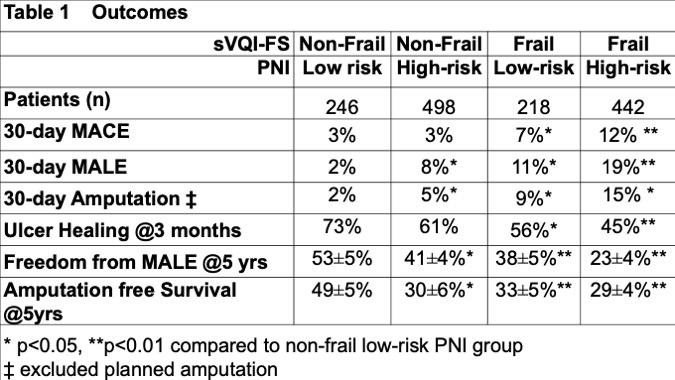Objective: Poor nutrition and frailty is a common finding among surgical patients and predicts poor surgical outcomes. The aim of this study was to analyze impact of nutrition and frailty on the outcomes of patients undergoing a lower extremity intervention for chronic limb-threatening ischemia (CLTI).
Methods: Between 2018 and 2022, all patients undergoing a primary intervention for CLTI (bypass, BYP; endovascular interventions, EV;, or major amputation, AMP) were analyzed. Frailty was assessed by the Simple Vascular Quality Initiative-Frailty Score (sVQI-FS; congestive heart failure, renal impairment, chronic obstructive pulmonary disease, not living at home, not ambulatory, anemia, and underweight status). A sVQI-FS score of 0.3 or greater was considered frail. Nutritional status was measured by the prognostic nutritional index (PNI 10 × serum albumin (g/dl) + 0.005 × total lymphocyte count (per mm3). High-risk PNI was scored <40. Amputation-free survival (AFS; survival without major amputation) and freedom from major adverse limb events (MALE; Above ankle amputation of the index limb or major re-intervention (new bypass graft, jump/interposition graft revision) were evaluated.
Results: 1404 patients ( 61% male, age 64ą12years, meanąSD) underwent either EV (55%), a BYP (31%), or AMP (14%). 25% were considered frail on initial evaluation. Similarly, 67% were considered to have High-risk PNI, and the remainder to have a Low-risk PNI. High baseline nutritional risk impacts early and late freedom from MALE and AFS. The presence of frailty had a similar effect, but there was a negative synergy when frailty and nutritional risk are taken together (Table 1).
Conclusions: There is a high baseline nutritional risk in CLTI at baseline. The combination of being at high nutritional risk and being identified as frail identified a high-risk cohort for poor short-term and long-term outcomes after intervention for CLTI. Assessing and addressing nutritional risk may improve outcomes before major lower extremity intervention. 